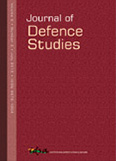The Line of Control: Travelling with Indian and Pakistani Armies, by Happymon Jacob
India–Pakistan relations have become more complicated in the aftermath of the Pulwama attack that took place in February 2019, on the Central Reserve Police Force (CRPF) personnel in the most volatile territory of India, Jammu and Kashmir (J&K). That the diplomatic ties between the two countries are arguably decided by what happens in the state has never been understated—precisely why Kashmir has remained the focus of study for experts on the topic.
- Shrabana Barua |
- July-September 2019 |
- Journal of Defence Studies





